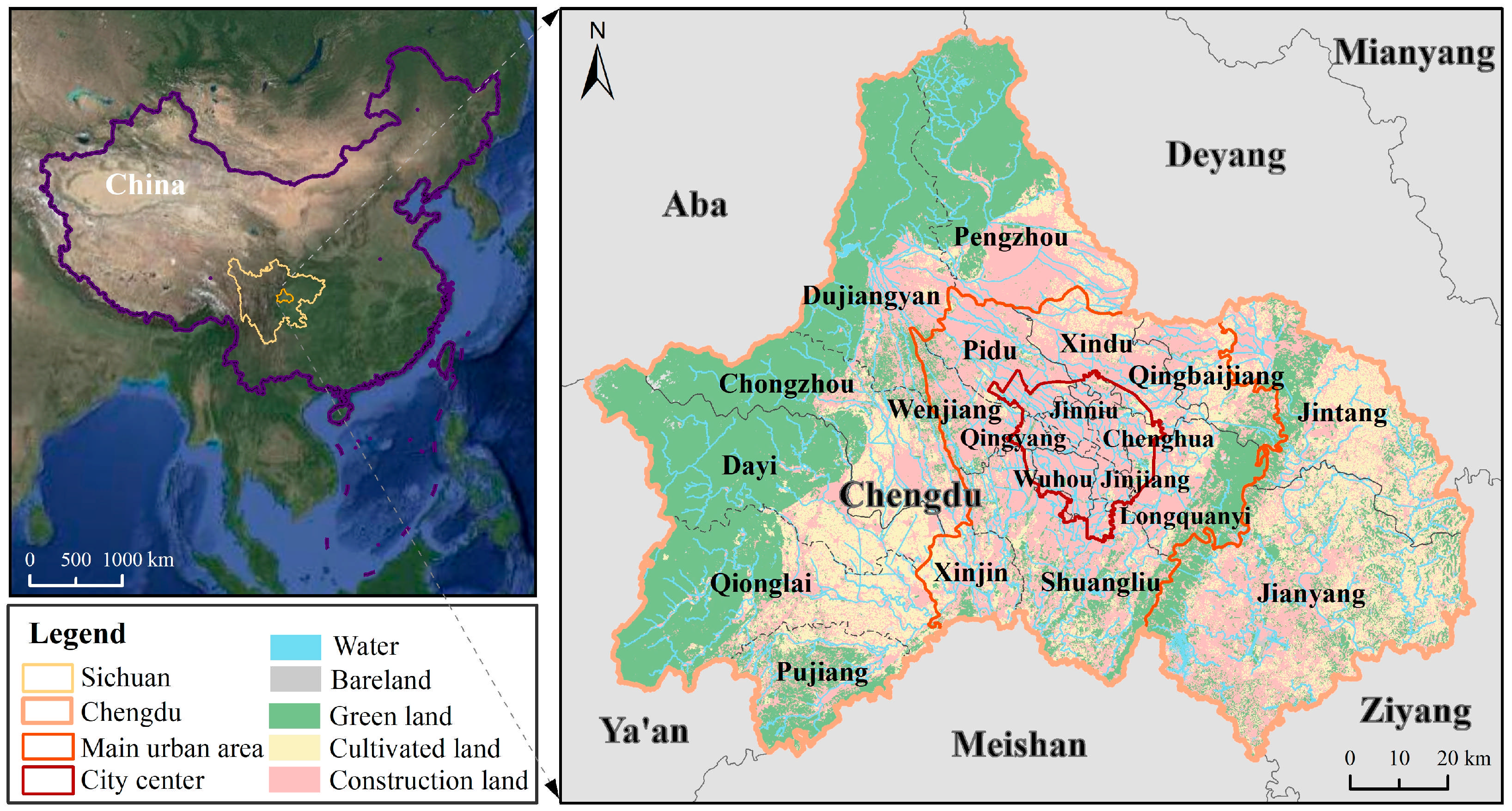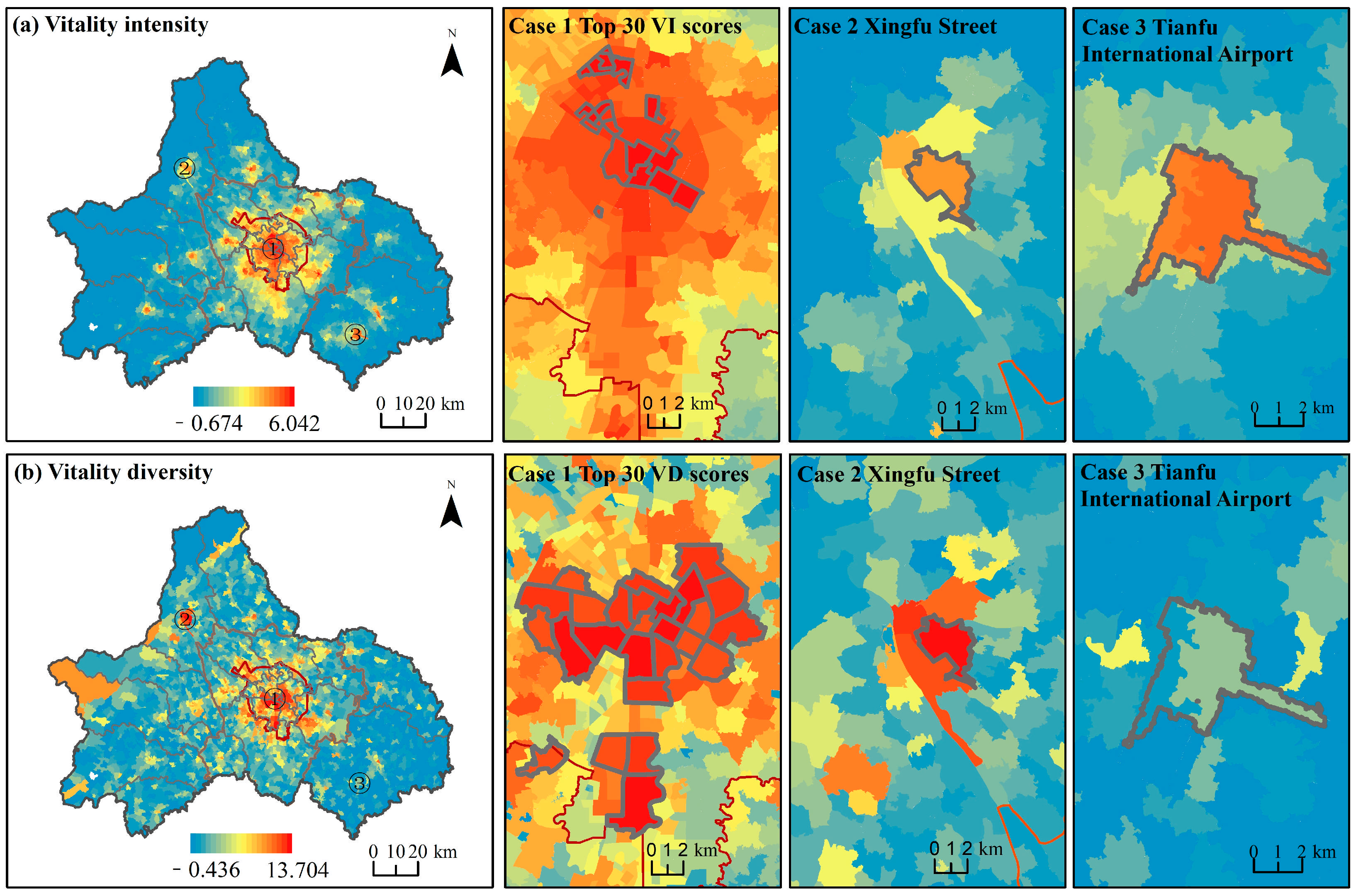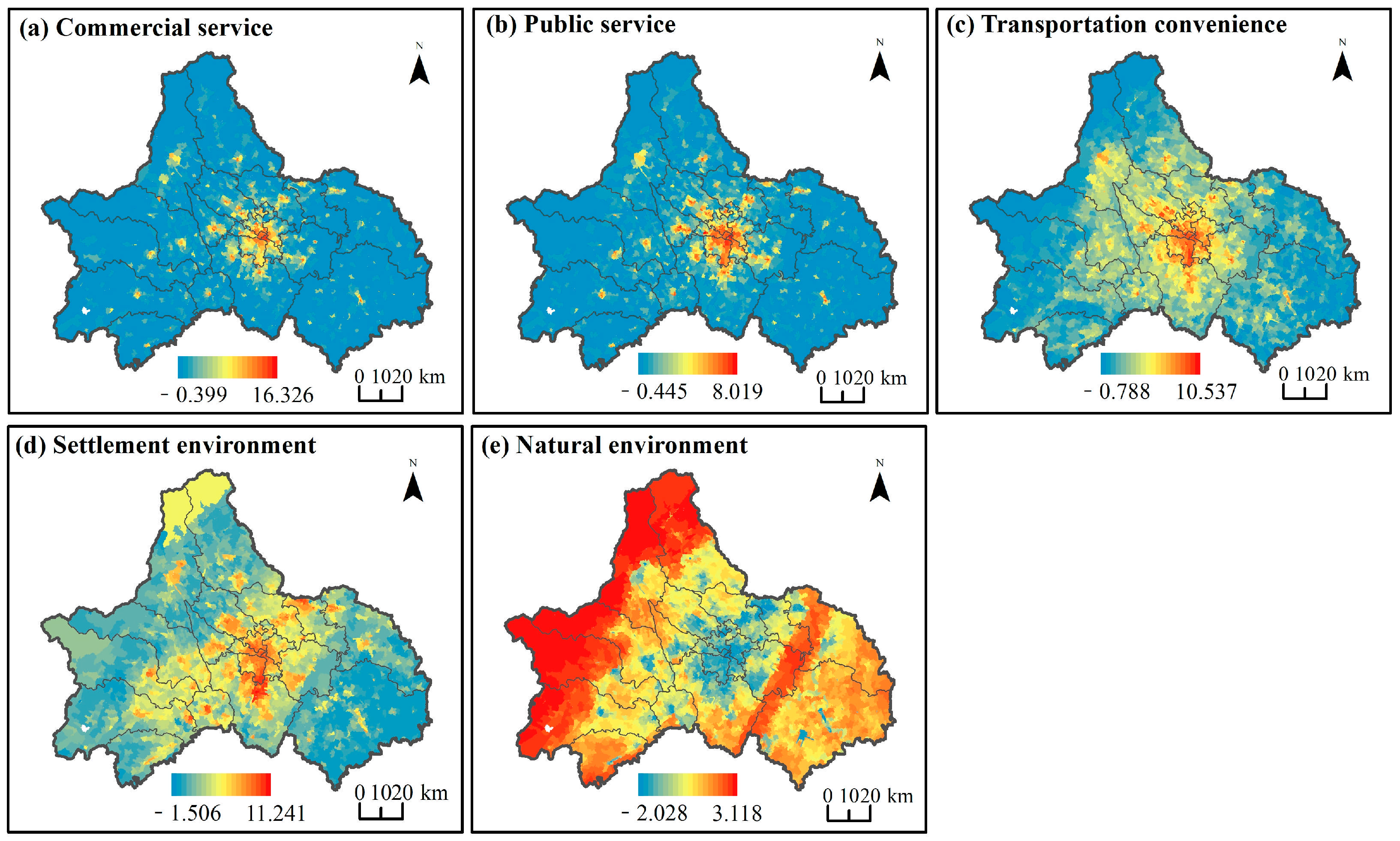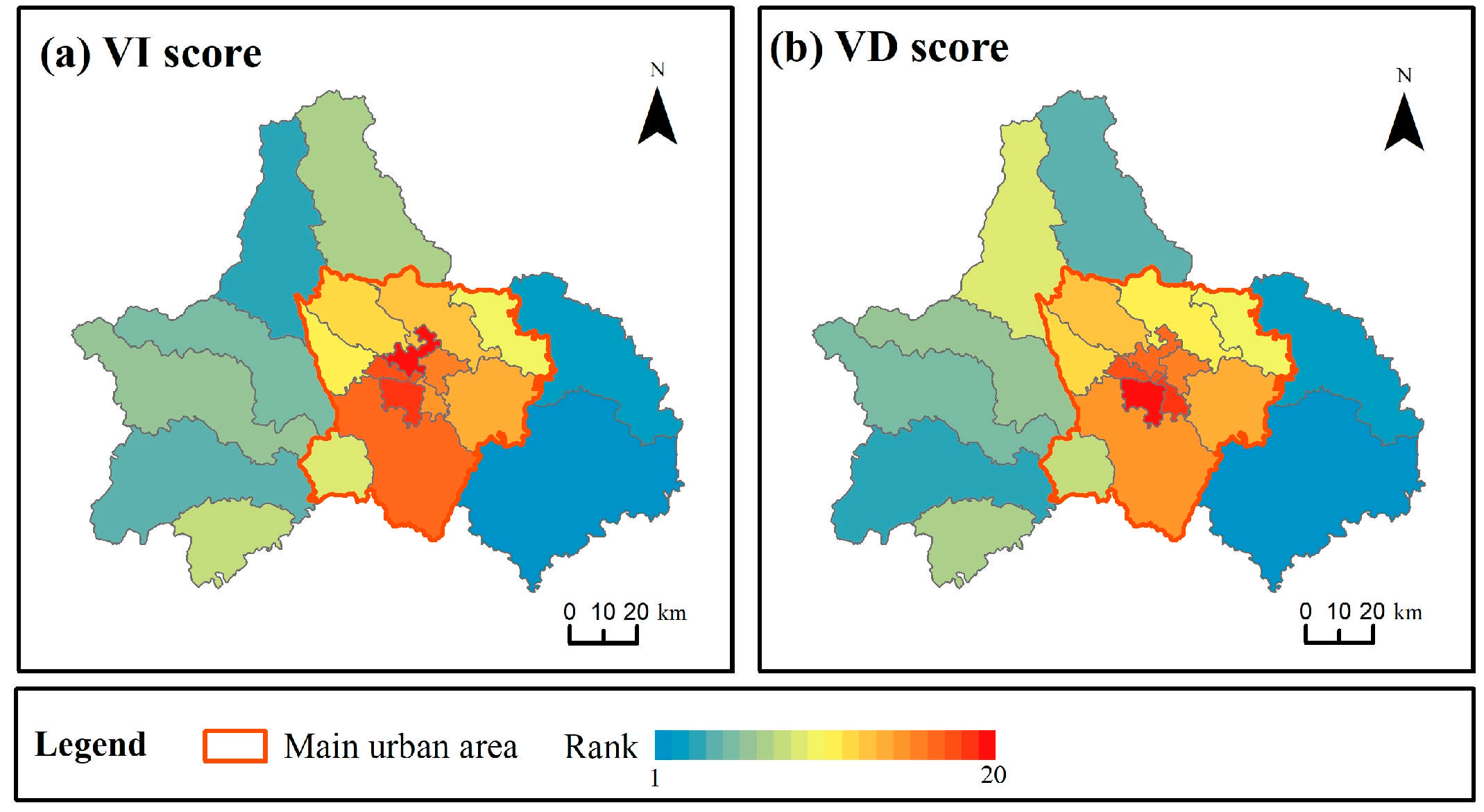Community-Level Urban Vitality Intensity and Diversity Analysis Supported by Multisource Remote Sensing Data
Abstract
:1. Introduction
2. Materials and Methods
2.1. Study Area and Dataset
2.1.1. Study Area
2.1.2. Data Collection
2.2. Urban Vitality Indicators
2.3. Multidimensional Vitality-Related Factors
2.3.1. Variable Description
2.3.2. Variable Calculation
2.4. PLS-SEM
3. Results
3.1. Urban Vitality in Chengdu
3.2. Urban Vitality Related Factors
3.2.1. Correlation Analysis
3.2.2. Spatial Distribution Features
3.2.3. Association Mechanisms
4. Discussion
4.1. Divergent Mechanisms Between VI and VD
4.2. Balancing Urban Vitality for Sustainable Development
4.3. Limitations and Future Research
5. Conclusions
Author Contributions
Funding
Data Availability Statement
Acknowledgments
Conflicts of Interest
References
- Chen, Y.; Yu, B.; Shu, B.; Yang, L.; Wang, R. Exploring the spatiotemporal patterns and correlates of urban vitality: Temporal and spatial heterogeneity. Sustain. Cities Soc. 2023, 91, 104440. [Google Scholar] [CrossRef]
- Zhou, L.; Yuan, B.; Hu, F.; Wei, C.; Dang, X.; Sun, D. Understanding the effects of 2D/3D urban morphology on land surface temperature based on local climate zones. Build. Environ. 2022, 208, 108578. [Google Scholar] [CrossRef]
- Mouratidis, K.; Poortinga, W. Built environment, urban vitality and social cohesion: Do vibrant neighborhoods foster strong communities? Landsc. Urban Plan. 2020, 204, 103951. [Google Scholar] [CrossRef]
- Zografos, C.; Klause, K.A.; Connolly, J.J.; Anguelovski, I. The everyday politics of urban transformational adaptation: Struggles for authority and the Barcelona superblock project. Cities 2020, 99, 102613. [Google Scholar] [CrossRef]
- Maas, P.R. Towards a Theory of Urban Vitality; University of British Columbia: Vancouver, BC, Canada, 1984. [Google Scholar]
- Smith, T.; Nelischer, M.; Perkins, N. Quality of an urban community: A framework for understanding the relationship between quality and physical form. Landsc. Urban Plan. 1997, 39, 229–241. [Google Scholar] [CrossRef]
- Liu, H.; Gou, P.; Xiong, J. Vital triangle: A new concept to evaluate urban vitality. Comput. Environ. Urban Syst. 2022, 98, 101886. [Google Scholar] [CrossRef]
- Li, S.; Chen, P.; Hui, F.; Gong, M. Evaluating urban vitality and resilience under the influence of the COVID-19 pandemic from a mobility perspective: A case study in Shenzhen, China. J. Transp. Geogr. 2024, 117, 103886. [Google Scholar] [CrossRef]
- Zhang, A.; Xia, C.; Chu, J.; Lin, J.; Li, W.; Wu, J. Portraying urban landscape: A quantitative analysis system applied in fifteen metropolises in China. Sustain. Cities Soc. 2019, 46, 101396. [Google Scholar] [CrossRef]
- Kim, Y.-L. Data-driven approach to characterize urban vitality: How spatiotemporal context dynamically defines Seouls nighttime. Int. J. Geogr. Inf. Sci. 2020, 34, 1235–1256. [Google Scholar] [CrossRef]
- Liu, M.; Jiang, Y.; He, J. Quantitative evaluation on street vitality: A case study of Zhoujiadu community in Shanghai. Sustainability 2021, 13, 3027. [Google Scholar] [CrossRef]
- Yue, W.; Chen, Y.; Zhang, Q.; Liu, Y. Spatial explicit assessment of urban vitality using multi-source data: A case of Shanghai, China. Sustainability 2019, 11, 638. [Google Scholar] [CrossRef]
- Martí, P.; Serrano-Estrada, L.; Nolasco-Cirugeda, A. Social media data: Challenges, opportunities and limitations in urban studies. Comput. Environ. Urban Syst. 2019, 74, 161–174. [Google Scholar] [CrossRef]
- Zhang, Z.; Liu, J.; Wang, C.; Zhao, Y.; Zhao, X.; Li, P.; Sha, D. A spatial projection pursuit model for identifying comprehensive urban vitality on blocks using multisource geospatial data. Sustain. Cities Soc. 2024, 100, 104998. [Google Scholar] [CrossRef]
- Guo, X.; Chen, H.; Yang, X. An evaluation of street dynamic vitality and its influential factors based on multi-source big data. ISPRS Int. J. Geo-Inf. 2021, 10, 143. [Google Scholar] [CrossRef]
- Tu, W.; Zhu, T.; Xia, J.; Zhou, Y.; Lai, Y.; Jiang, J.; Li, Q. Portraying the spatial dynamics of urban vibrancy using multisource urban big data. Comput. Environ. Urban Syst. 2020, 80, 101428. [Google Scholar] [CrossRef]
- Wang, Z.; Xia, N.; Zhao, X.; Gao, X.; Zhuang, S.; Li, M. Evaluating Urban Vitality of Street Blocks Based on Multi-Source Geographic Big Data: A Case Study of Shenzhen. Int. J. Environ. Res. Public Health 2023, 20, 3821. [Google Scholar] [CrossRef]
- Jiang, Y.; Huang, Z.; Zhou, X.; Chen, X. Evaluating the impact of urban morphology on urban vitality: An exploratory study using big geo-data. Int. J. Digit. Earth 2024, 17, 2327571. [Google Scholar] [CrossRef]
- Pan, H.; Yang, C.; Quan, L.; Liao, L. A new insight into understanding urban vitality: A case study in the Chengdu-Chongqing area twin-city economic circle, China. Sustainability 2021, 13, 10068. [Google Scholar] [CrossRef]
- Wang, Z.; Wang, X.; Liu, Y.; Zhu, L. Identification of 71 factors influencing urban vitality and examination of their spatial dependence: A comprehensive validation applying multiple machine-learning models. Sustain. Cities Soc. 2024, 108, 105491. [Google Scholar] [CrossRef]
- Xiao, Z.; Li, C.; Pan, S.; Wei, G.; Tian, M.; Hu, R. Exploring the Spatial Impact of Multisource Data on Urban Vitality: A Causal Machine Learning Method. Wirel. Commun. Mob. Comput. 2022, 1, 5263376. [Google Scholar] [CrossRef]
- Liu, S.; Zhang, L.; Long, Y. Urban vitality area identification and pattern analysis from the perspective of time and space fusion. Sustainability 2019, 11, 4032. [Google Scholar] [CrossRef]
- Ye, Y.; Li, D.; Liu, X. How block density and typology affect urban vitality: An exploratory analysis in Shenzhen, China. Urban Geogr. 2018, 39, 631–652. [Google Scholar] [CrossRef]
- Najaf, P.; Thill, J.-C.; Zhang, W.; Fields, M.G. City-level urban form and traffic safety: A structural equation modeling analysis of direct and indirect effects. J. Transp. Geogr. 2018, 69, 257–270. [Google Scholar] [CrossRef]
- Fan, Y.; Chen, J.; Shirkey, G.; John, R.; Wu, S.R.; Park, H.; Shao, C. Applications of structural equation modeling (SEM) in ecological studies: An updated review. Ecol. Process. 2016, 5, 19. [Google Scholar] [CrossRef]
- Chengdu Yearbook Society. Chengdu Yearbook; Chengdu Yearbook Press: Chengdu, China, 2022. [Google Scholar]
- Chengdu Municipal Statistics Bureau. The 2023 Chengdu Statistical Bulletin of National Economic and Social Development; Chengdu Municipal Statisties Bureau: Chengdu, China, 2023. [Google Scholar]
- Che, Y.; Li, X.; Liu, X.; Wang, Y.; Liao, W.; Zheng, X.; Zhang, X.; Xu, X.; Shi, Q.; Zhu, J.; et al. 3D-GloBFP: The first global three-dimensional building footprint dataset. Earth Syst. Sci. Data 2024, 16, 5357–5374. [Google Scholar] [CrossRef]
- Wei, J.; Li, Z.; Lyapustin, A.; Sun, L.; Peng, Y.; Xue, W.; Su, T.; Cribb, M. Reconstructing 1-km-resolution high-quality PM2.5 data records from 2000 to 2018 in China: Spatiotemporal variations and policy implications. Remote Sens. Environ. 2021, 252, 112136. [Google Scholar] [CrossRef]
- Karra, K.; Kontgis, C.; Statman-Weil, Z.; Mazzariello, J.C.; Mathis, M.; Brumby, S.P. Global land use/land cover with Sentinel 2 and deep learning. In Proceedings of the 2021 IEEE International Geoscience and Remote Sensing Symposium IGARSS, Brussels, Belgium, 11–16 July 2021; pp. 4704–4707. [Google Scholar]
- Yang, J.; Dong, J.; Xiao, X.; Dai, J.; Wu, C.; Xia, J.; Zhao, G.; Zhao, M.; Li, Z.; Zhang, Y.; et al. Divergent shifts in peak photosynthesis timing of temperate and alpine grasslands in China. Remote Sens. Environ. 2019, 233, 111395. [Google Scholar] [CrossRef]
- Duan, J.; Wang, H.; Liu, L.; Zhang, J. The attraction gradient of urban functions: How does functional mix at multiple scales predict urban vitality. Cities 2025, 156, 105516. [Google Scholar] [CrossRef]
- Zhou, L.; Wei, L.; López-Carr, D.; Dang, X.; Yuan, B.; Yuan, Z. Identification of irregular extension features and fragmented spatial governance within urban fringe areas. Appl. Geogr. 2024, 162, 103172. [Google Scholar] [CrossRef]
- Doan, Q.C.; Ma, J.; Chen, S.; Zhang, X. Nonlinear and threshold effects of the built environment, road vehicles and air pollution on urban vitality. Landsc. Urban Plan. 2025, 253, 105204. [Google Scholar] [CrossRef]
- Wang, C.; Ma, L.; Zhang, Y.; Chen, N.; Wang, W. Spatiotemporal dynamics of wetlands and their driving factors based on PLS-SEM: A case study in Wuhan. Sci. Total Environ. 2022, 806, 151310. [Google Scholar] [CrossRef] [PubMed]
- Jin, A.; Ge, Y.; Zhang, S. Spatial Characteristics of Multidimensional Urban Vitality and Its Impact Mechanisms by the Built Environment. Land 2024, 13, 991. [Google Scholar] [CrossRef]
- Zhan, D.; Kwan, M.-P.; Zhang, W.; Fan, J.; Yu, J.; Dang, Y. Assessment and determinants of satisfaction with urban livability in China. Cities 2018, 79, 92–101. [Google Scholar] [CrossRef]
- Chen, M.; Cai, Y.; Guo, S.; Sun, R.; Song, Y.; Shen, X. Evaluating implied urban nature vitality in San Francisco: An interdisciplinary approach combining census data, street view images, and social media analysis. Urban For. Urban Green. 2024, 95, 128289. [Google Scholar] [CrossRef]
- Goward, S.N.; Markham, B.; Dye, D.G.; Dulaney, W.; Yang, J. Normalized difference vegetation index measurements from the advanced very high resolution radiometer. Remote Sens. Environ. 1991, 35, 257–277. [Google Scholar] [CrossRef]
- Jöreskog, K.G. A general approach to confirmatory maximum likelihood factor analysis. Psychometrika 1969, 34, 183–202. [Google Scholar] [CrossRef]
- Leguina, A. A primer on partial least squares structural equation modeling (PLS-SEM). Int. J. Res. Method Educ. 2015, 38, 220–221. [Google Scholar] [CrossRef]
- Hair, J.F.; Ringle, C.M.; Sarstedt, M. Partial least squares structural equation modeling: Rigorous applications, better results and higher acceptance. Long Range Plan. 2013, 46, 1–12. [Google Scholar] [CrossRef]
- Hair, J.F.; Sarstedt, M.; Ringle, C.M.; Mena, J.A. An assessment of the use of partial least squares structural equation modeling in marketing research. J. Acad. Mark. Sci. 2012, 40, 414–433. [Google Scholar] [CrossRef]
- Chao, Y.; Gao, L.; Liu, Y.; Yang, N.; Lyu, X.; Zhang, Y.; Guan, Q. Multi-perspective perception of urban relative poverty and its associated factors analysis: A case study of Wuhan City. Cities 2024, 153, 105320. [Google Scholar] [CrossRef]
- Busch, J.; Amarjargal, O. 100 global bright spots of green growth: Co-occurrence of nighttime light gain and forest gain, 1990–2015. Glob. Environ. Chang. 2022, 75, 102556. [Google Scholar] [CrossRef]
- Li, Q.; Cui, C.; Liu, F.; Wu, Q.; Run, Y.; Han, Z. Multidimensional Urban Vitality on Streets: Spatial Patterns and Influence Factor Identification Using Multisource Urban Data. ISPRS Int. J. Geo-Inf. 2021, 11, 2. [Google Scholar] [CrossRef]
- Folke, C.; Polasky, S.; Rockström, J.; Galaz, V.; Westley, F.; Lamont, M.; Scheffer, M.; Österblom, H.; Carpenter, S.R.; Chapin, F.S., III; et al. Our future in the Anthropocene biosphere. Ambio 2021, 50, 834–869. [Google Scholar] [CrossRef] [PubMed]








| Data Name | Data Source | Resolution (m) | Time (Year) | Type |
|---|---|---|---|---|
| Administrative boundary | Tianditu | - | 2024 | Vector |
| Bus station | AMAP | - | 2024 | Vector |
| Subway station | AMAP | - | 2024 | Vector |
| POI | AMAP | - | 2022 | Vector |
| River | OpenStreetMap | - | 2024 | Vector |
| Road | OpenStreetMap | - | 2024 | Vector |
| Building [28] | Zenodo | - | 2020 | Vector |
| Geohazard point | zldatas | - | 2024 | Vector |
| PM2.5 [29] | Zenodo | 1000 × 1000 | 2023 | Raster |
| Population | WorldPop | 100 × 100 | 2020 | Raster |
| LULC [30] | Esri Sentinel-2 Land cover | 10 × 10 | 2020 | Raster |
| NTL [5] | NPP/VIIRS | 500 × 500 | 2023 | Raster |
| NDVI [31] | National Ecosystem Science Data Center (NESDC) | 30 × 30 | 2022 | Raster |
| DEM | ASF ALOS | 12.5 × 12.5 | 2022 | Raster |
| Latent Variables | Observed Variables | Description | Unit | Data Source |
|---|---|---|---|---|
| Vitality intensity (VI) | PD | Population density | persons/km2 | (a) |
| NTL | Nighttime light value | nw/cm2/sr | (b) | |
| POID | POI density | POIs/km2 | (c) | |
| Vitality diversity (VD) | POIMD | POI mix degree | - | (c) |
| LUMD | Land use mix degree | - | (d) | |
| Commercial service (CS) | HA | POI density of surrounding hotel and accommodation services | POIs/km2 | (c) |
| DF | POI density of surrounding dining and food services | POIs/km2 | (c) | |
| SS | POI density of surrounding shopping services | POIs/km2 | (c) | |
| Public service (PS) | SF | POI density of surrounding sports and fitness services | POIs/km2 | (c) |
| HC | POI density of surrounding healthcare services | POIs/km2 | (c) | |
| EC | POI density of surrounding education and culture services | POIs/km2 | (c) | |
| Transportation environment (TE) | BSD | Bus station density | stations/km2 | (e) |
| DNSS | Distance to the nearest subway station | km | (f) | |
| RL | Length of roads per square kilometers | km/km2 | (g) | |
| CD | Crossroad density | crossroads/km2 | (g) | |
| Residential environment (RE) | FAR | Floor area ratio | - | (h) |
| ABH | Average building height | m | (h) | |
| BF | Building footprint | m2 | (h) | |
| Natural environment (NE) | NDVI | Normalized difference vegetation index | - | (i) |
| GR | Green ratio | % | (d) | |
| PM2.5 | PM2.5 | μg/m3 | (j) | |
| Slope | Slope | (k) | ||
| GDD | Geological disaster density | events/km2 | (l) |
| Model | Crobach’s | CR | AVE | Correlation |
|---|---|---|---|---|
| Model 1 | ||||
| CS | 0.834 | 0.900 | 0.752 | 0.842 |
| PS | 0.889 | 0.931 | 0.819 | 0.850 |
| TC | 0.808 | 0.886 | 0.723 | 0.796 |
| RE | 0.844 | 0.928 | 0.865 | 0.707 |
| NE | 0.839 | 0.889 | 0.728 | −0.656 |
| VI | 0.913 | 0.888 | 0.726 | 1.000 |
| Model 2 | ||||
| CS | 0.834 | 0.901 | 0.754 | 0.541 |
| PS | 0.889 | 0.931 | 0.819 | 0.565 |
| TC | 0.808 | 0.887 | 0.723 | 0.525 |
| RE | 0.844 | 0.928 | 0.865 | 0.445 |
| NE | 0.839 | 0.889 | 0.729 | −0.362 |
| VD | — | — | — | 1.000 |
| Latent Variables | Path Coefficient | Observed Variables | Factor Loading | ||
|---|---|---|---|---|---|
| VI | VD | VI | VD | ||
| CS | 0.344 | 0.162 | HA | 0.767 | 0.790 |
| SS | 0.879 | 0.863 | |||
| DF | 0.947 | 0.944 | |||
| PS | 0.219 | 0.228 | SF | 0.876 | 0.884 |
| HC | 0.891 | 0.882 | |||
| EC | 0.946 | 0.947 | |||
| TC | 0.253 | 0.214 | BSD | 0.795 | 0.791 |
| CD | 0.858 | 0.864 | |||
| RL | 0.894 | 0.894 | |||
| RE | 0.106 | 0.069 | ABH | 0.923 | 0.928 |
| FAR | 0.937 | 0.932 | |||
| NE | −0.166 | −0.002 | Slope | 0.799 | 0.800 |
| GR | 0.854 | 0.854 | |||
| NDVI | 0.904 | 0.904 | |||
Disclaimer/Publisher’s Note: The statements, opinions and data contained in all publications are solely those of the individual author(s) and contributor(s) and not of MDPI and/or the editor(s). MDPI and/or the editor(s) disclaim responsibility for any injury to people or property resulting from any ideas, methods, instructions or products referred to in the content. |
© 2025 by the authors. Licensee MDPI, Basel, Switzerland. This article is an open access article distributed under the terms and conditions of the Creative Commons Attribution (CC BY) license (https://creativecommons.org/licenses/by/4.0/).
Share and Cite
Zhang, Z.; Liu, J.; Zhao, Y.; Zhou, Q.; Song, L.; Xu, S. Community-Level Urban Vitality Intensity and Diversity Analysis Supported by Multisource Remote Sensing Data. Remote Sens. 2025, 17, 1056. https://doi.org/10.3390/rs17061056
Zhang Z, Liu J, Zhao Y, Zhou Q, Song L, Xu S. Community-Level Urban Vitality Intensity and Diversity Analysis Supported by Multisource Remote Sensing Data. Remote Sensing. 2025; 17(6):1056. https://doi.org/10.3390/rs17061056
Chicago/Turabian StyleZhang, Zhiran, Jiping Liu, Yangyang Zhao, Qing Zhou, Lijun Song, and Shenghua Xu. 2025. "Community-Level Urban Vitality Intensity and Diversity Analysis Supported by Multisource Remote Sensing Data" Remote Sensing 17, no. 6: 1056. https://doi.org/10.3390/rs17061056
APA StyleZhang, Z., Liu, J., Zhao, Y., Zhou, Q., Song, L., & Xu, S. (2025). Community-Level Urban Vitality Intensity and Diversity Analysis Supported by Multisource Remote Sensing Data. Remote Sensing, 17(6), 1056. https://doi.org/10.3390/rs17061056






